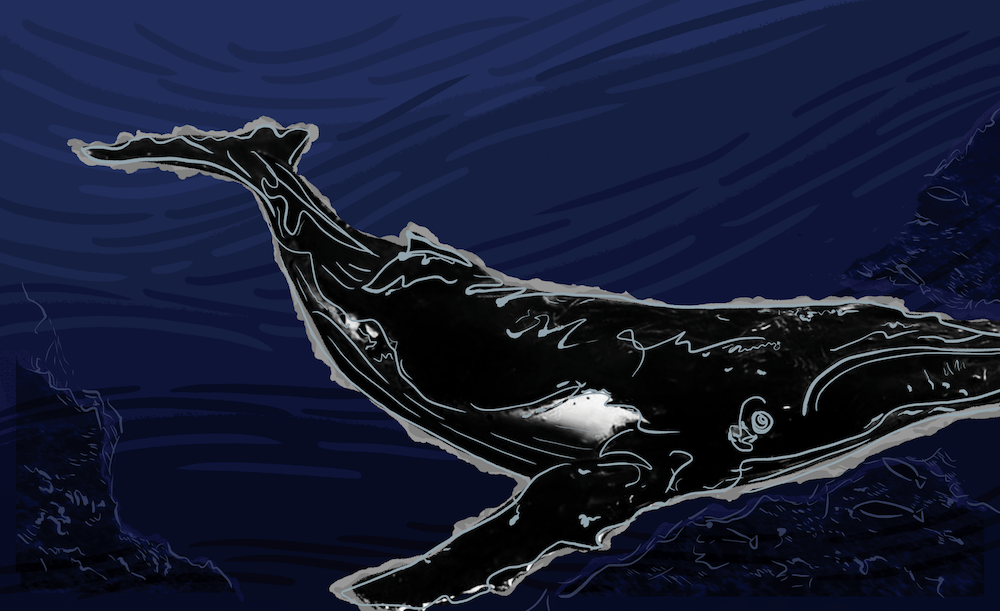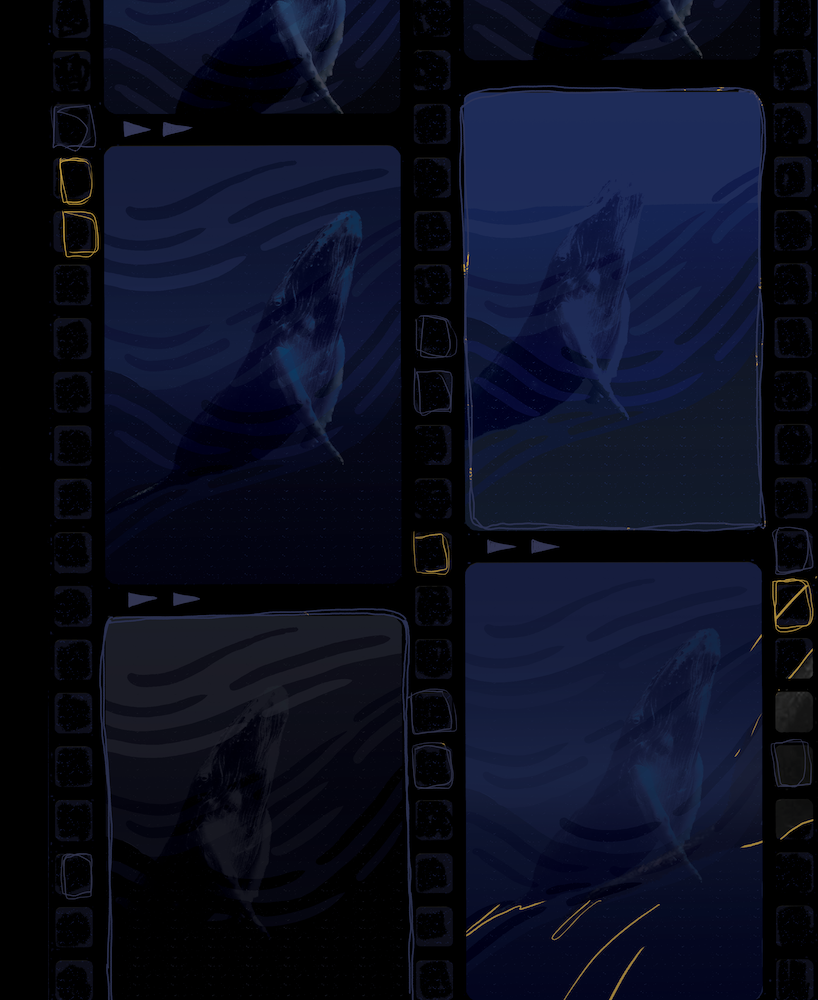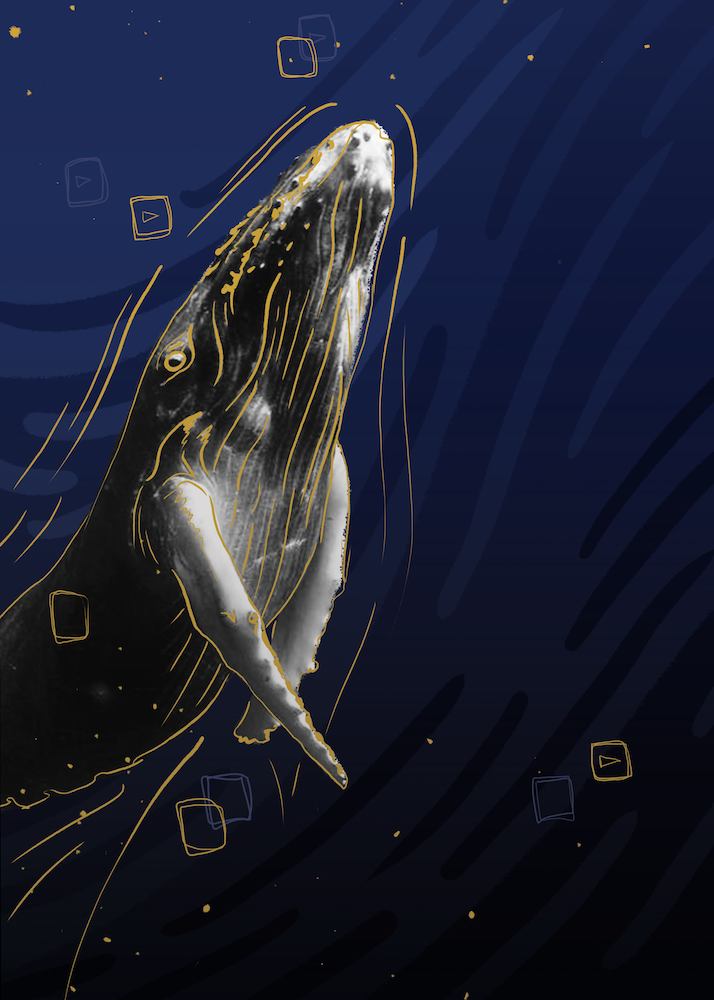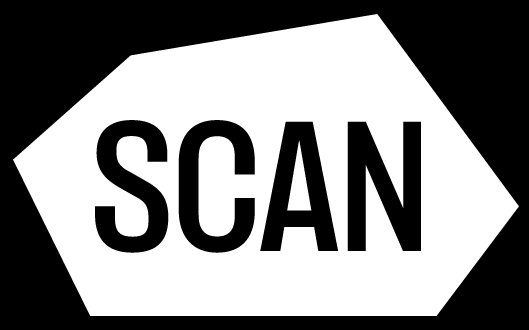Web-exclusive full interview with SCAD alumni behind Emmy-winning documentary series, “Secrets of the Whales.”
To read The Connector’s review of “Secrets of the Whales,” click here.
Interviewed and illustrated by Julie Tran
Shannon Malone-deBenedictis is a SCAD alumna (class of 1992) and the Senior Vice President of Production and Development at Red Rock Films — one of North America’s leading production companies in natural history programming. Their recent Disney+ limited series, “Secrets of the Whales” has won a Primetime Emmys for Best Documentary or Nonfiction Series.
Jay Danner-McDonald is a SCAD alumnus (class of 1993) and an editor for “Secrets of the Whales.” He regularly works with National Geographic, Discovery Channel, History Channel, The Learning Channel and more.

Were you there? Did you see the whales?
Malone-deBenedictis: Yeah. I helped develop the project from the very beginning, and it was about three-and-a-half years ago that I worked with National Geographic to shape how we were going to film this and what we were going to do. I went out on the very first shoot, which was in Sitka, Alaska. We were profiling humpback whales and how they work collaboratively together to “bubble-feed” — where the whales collectively swim around and create bubbles, which creates a vacuum that all of the prey can be caught up in, and then the whales can have a “buffet feast.” So I was out on that shoot. And then back at our headquarters I worked on making sure that the teams were sent out and everybody was safe. We were filming for about two-and-a-half years, all over the world. It ranged from Sri Lanka to the Arctic up in Northern Canada. Just an incredible experience.
How do you even begin to put together such a big project?
Malone-deBenedictis: Red Rock Films, we’ve been in existence for over 10 years now and we have a reputation with our clients in networks as being collaborators on ideas. Janet Vissering, the SVP of Program Development and Production at NatGeo WILD, called us into her office and said, “We’d like you to meet a National Geographic photographer, Brian Skerry. He has an idea about whales and the culture of whales. We think this could be a documentary. What do you think?” And I said, “Well, let me meet with him and let’s sit down and let’s kind of go through it.”
So I spent a lot of time with Brian and we looked at what he had and looked at all the different things where we could film and said, “You know, we think we can actually get four episodes out of this. We think we can do a limited series and profile different whales.” Because it was incredibly interesting to see how each whale had a different aspect of culture. They were really, really unique. So when we were looking at this, we were saying we just don’t want to talk about things like “This is whales, look at them, they’re pretty.” We want to tell a story, and we want to reveal new information and put those pieces together. So I worked with him, came up with a very long proposal, went back to the executives at National Geographic, who have known me for years as a producer and developer, then said, “You know we can do this,” and they said “OK, let’s go for it.”
So we started filming and gradually it became clear that the project was bigger. It was becoming really phenomenal. We were coming back with rushes from the field of just extraordinary behavior and we saw the story more clearly. We were lucky the whales cooperated. Our directors of photography were phenomenal. Everything came together and we knew we had something special. And so to national geographic and Disney. It was a really big collaborative effort to get it up off the ground and then recognizing while we were filming that something big was happening.
What was your creative process like, as to deciding how to film while learning more about the whales?
Malone-deBenedictis: So I think it’s a two-part process: We start in the field, and we work with local scientists and experts on where it’s going to be the best place to capture the whales in their natural environment. We don’t want to disturb things. We want to make sure that it’s you know we adhere to really high ethical standards of any animal that we film, to make sure that we’re not disturbing their habitat or disturbing them. So we work with experts and we make sure that our filmmakers, our DPs, out there are able to capture the action, but the entire time our producers are thinking in their heads, “Okay, how is this going to work in a narrative structure to put together? What story are we trying to tell?” We’re looking and saying, “Okay, this could be a 12-minute segment about motherhood or about solidarity.” And then the next stage is we have this amazing footage from the DPs that we hand to incredible editors who work with our producers. And I’m going to throw it to Jay now.
Danner-McDonald: There was so much beautiful footage that was coming in. You have to go through it all to actually understand what’s happening, and you have notes from the field of the story producers saying “The whales are doing this, we found them doing this,” which in many cases, especially this series, was the stuff that folks haven’t seen before. So we were trying to figure out how to show this in a way that viewers would actually understand and sympathize with.
Beluga whales, for instance, migrate. They go from living under ice — which makes it extremely hard to find them — then migrating through deadly waters with killer whales, to getting to this beautiful warm beach where they exfoliate themselves. The producers in the field were saying, “This is what’s happening and it’s kind of like going on vacation.” So we then tried to build from the footage: we set up a family unit when it’s travelling, when it’s in danger. The whales are not sitting down for interviews, so you have to meld it together frame-by-frame to really tell a story and convey movements. The whales are going into a place, it’s scary, and with this series there’s so much footage to convey that. Some of the shots that we got of ice floats where these whales could come up and the ice floats could cut them — there’s danger everywhere. So it’s gotten a little easier to figure out the reasoning for them to migrate.
There’s so much footage of the whales from different angles as well. It’s kind of different from other natural history shows which usually are from one perspective. For this one, because we were in the Arctic, a lot of it was drone footage. The story producers were so good in hunting down where these animals will be, and the Red Rock DPs were always good at capturing emotions and actions from animals. It allows the editor to tell such great stories, give pacing and give the whales a life that you can relate to as a family.
Do you feel a special attraction to wildlife documentaries and the nonfiction genre as opposed to films and fictional stories?
Malone-deBenedictis: Well, I think I’ve been drawn to documentaries in the same way I’m drawn to any other film or any other narrative structure: it’s all about the story. Whether you’re telling the migration patterns of beluga whales or you’re watching the Marvel’s Avengers fight off Thanos, it’s still a great story that you’re putting together. What are those elements that really pull you in emotionally, that makes you happy, makes you sad, makes you angry, makes you want to do something? So when I look at the documentaries, I’m drawn to the real elements in the world. What are the real things that are happening that have those touch points that really connect to me? We did a series on Netflix called “Penguin Town,” which is about the jackass penguins in Simon’s Town, South Africa and how they come every summer to breed, live their summer and then go back out in the ocean. But it’s not just about the penguins, this is about a species of males and females trying to survive and thrive in this town. It has narrative elements that connect to the same things we deal with, the same things that we look for in all our stories.
I also love learning. I’ve always loved learning and I’m so thankful that I have a job that allows me to go and dive into a space, do all this research, absorb it and become an expert. That’s one of the really wonderful things about doing documentaries — learning about our world and then finding stories to tell.
Danner-McDonald: It’s the same for me. It’s learning and taking the science and being able to put it into a box that every viewer will understand. It basically comes down to story, story, story. In nature, it’s about how you take the stories that people don’t pay too much attention to and put it in a spotlight. It’s making the viewer go, “Oh my God, that mother has to raise a child on her own, and now there’s a killer whale coming.” That’s drama. Everyone has those kinds of weird, tense moments, and what’s great about nature documentaries is that you have to learn how it works in nature and convey it correctly, so that you’re able to convey a sense of story, of worry, of fear, of what the animals are going through. There’s a little more layers to natural history documentaries than other genres.

How long have you been in the industry?
Malone-deBenedictis: I came late to it. I graduated from SCAD in 1992 then went to graduate school in the 90s, and I didn’t start working in this industry until 1999 as an editor. I’m going on my 22nd year now, working in nonfiction TV.
Danner-McDonald: I graduated a year after 93 Shannon I knew each other at SCAD. I left and came up to DC. Around 1995 I started working professionally in the industry. And then in 1999 I called Sharon and pulled her away from her big Chicago job to edit for Discovery. So I take all the credit for this.
Malone-deBenedictis: And he deserves all the credits.
Danner-McDonald: At that time Avid [editing software] was just popping up, and she was like, “I don’t know anything about computers.” But I didn’t feel any insecurity about hiring her to become an editor at Discovery Channel because I could teach her how to use the tool, but what I couldn’t teach was the stuff that she already knew from SCAD, which was building a story, the technical expertise. She had all the chops coming in, she was great. She went flying through Discovery.
So both of you have been in this industry for a long time. How have you seen the wildlife documentary genre change over the years?
Malone-deBenedictis: I’ve seen the industry change in two ways. One is that the technology has just improved dramatically. So in wildlife filmmaking with the cameras that we’re able to use: the 4k, 8k ultra HD, night cameras, drones, we’re able to capture things that 20 years ago we never would have imagined. It’s evolved the industry to be able to reveal more behavior, more insight, and I hope because of that it’s allowed the audience to connect more to nature. The more we’re able to see, the more we care.
The second evolution is that there’s been a real shift in the appreciation of documentaries. Before it was limited to maybe just PBS and the occasional independent documentary. But with more outlets out there — Netflix, Hulu, Amazon, Apple, Discovery, Disney, you name it — documentaries have found a place and a home and people are watching them a lot more. So you see a lot of filmmakers getting into it, you see a bigger appreciation of documentaries. I know I’m watching a lot more. You flip on and there’s a new debut every week. It used to just be a handful of documentary filmmakers who are the people you knew that do documentaries, but now it’s become an inspiration for so many new filmmakers . It’s been wonderful to see.
In my company, we don’t just look at natural history filmmakers and say, “Okay we’re just going to watch them and then get inspiration.” I watched documentaries from all different types of genres to find new ways to tell stories, new topics, new approaches. There was a great documentary on HBO called “The Lady and the Dale” where they did a great job with limited archive and footage and they told a really provocative four-part series. So I’m always interested in seeing the innovations that are being used in documentaries and that’s been a huge change over the past few decades to me.
Danner-McDonald: In my editor’s perspective, the industry has been transported. Back when I started in the booth, edit suites cost $300,000 to $500,000 with all the machines you needed. Today applications are free, you just need to buy a $1,500 laptop.
I think the past 15 years of reality TV has a few things that can go back to documentaries where we’re trying to tell stories that are factual, but with a rapport, a relationship, how animals relate to us humans.
But one thing that really hasn’t changed is that you still have small shops dedicated to innovations, science, and stories that need to be told. What I love about working with Red Rock is that they’re always doing small shops with great core people who are really committed to a culture of learning and presenting epic stories. It can be a small digital product or an Emmy-nominated series. The passion that the folks at Red Rock have goes into that. It’s really been an amazing experience to work with them, to see all the stuff coming in, to work as a team and create really cool dreams. You know, if you can dream it, tell it to Shannon and she’ll develop it.
I want to know more on the environment in Red Rock, because it sounds like an awesome place, but first I want to ask: how was your experience working with huge corporations like Disney?
Malone-deBenedictis: We’ve been really fortunate. Red Rock has had relationships and has produced for Disney, Netflix, Discovery, Smithsonian’s, Sesame Street, and the corporate clients like WebMD, and we’re working on one right now with Wondrium. So we have a wide variety of clientele. One of the things that has been successful for us is we invest a lot of time in understanding what our clientele is looking for. Obviously, everybody wants the best quality. They want creativity and originality. And all clients have their unique audience base or their unique client base, so understanding who their clients are, who their viewers are is a huge part of developing an element, of bringing ideas to them.
It’s also really important with any corporation to be collaborative. It’s understanding what they want and shaping the editorial vision around what we can provide and we believe to be the best idea. I think it’s actually good from a creative standpoint, because if you have a very siloed creative vision on what you want to do, it can hurt you as a creative. I read a great article about documentary filmmaking that said, “You aren’t making this documentary yourself, you are making this documentary for everyone but yourself.” And so part of that is learning to collaborate with all the voices that are coming in and see that all these voices coming together is going to make the best possible product. We do anywhere between 10-30 films a year , so we have to make sure we’re collaborating with our clients, and they appreciate that we’re listening to their voice and that we respect their input.
In the grand scheme of things, Red Rock Film is a relatively small company. We have two offices, one in Silver Spring, Maryland and one in Johannesburg, South Africa. In total we have about 15 staff members. In comparison, many companies are part of a conglomerate. We’re an independent production house and what we provide to our freelancers and staff is an opportunity to be creative, to thrive and to grow. And we’re low-drama. We don’t have a lot of drama. We like to laugh. We do pull long hours because that’s just our industry, but we don’t expect people to pull long hours to prove themselves because that’s not how you prove yourself — you prove yourself by just doing really good work. For the most part, we’re ego-free. We’re working collectively to make really great films and everybody’s a part of it.
That said, we are strutting around a little bit because we’ve been nominated for three primetime Emmys. But we also recognize that it takes an army to produce these films and we are so thankful for everybody who’s a part in it.
Danner-McDonald: If I could answer from the freelance, independent contractor’s position, for the SCAD students who are graduating and going into the workforce as freelancers: Unless you have a lot of money in your background that you can pull from, you’re going to have to work with some clients that you might think is the “corporate enemy.” You’re gonna have to make money. The truth of it comes down to: you’re working with people. They might work for a big conglomerate, but there’s just one person you’re communicating with and they’re probably great, and they just want to make this story great. And you have to be able to understand where other people are coming from, work with them, and be able to adjust if you want to be a freelancer. It’s not super easy. You have to be able to communicate with people who think differently than you and get to an understanding with them.

To Danner-McDonald: I know that you graduated from SCAD but I actually didn’t know what major you were.
Danner-McDonald: Video production. I also came in as a painter and sculptor so I’ve been doing that as well.
Do you think the painting and sculpting side help with what you’re doing now?
Danner-McDonald: Most definitely. Whether it’s a flat surface or a 3D space, the same aspects apply: you’re telling a story and sharing emotions. Being able to think abstractly or realistically really helps with editing and pacing. I can edit from different perspectives. When you think about all those art movements — Surrealism would be with a funky musical beat, Dada would be all chaotic, etc.
To Malone-deBenedictis: Do you have other projects going on right now that you can tell us about?
Malone-deBenedictis: Sure. At Red Rock, this has been our biggest year so far. We’ve had “Secrets of the Whales,” we’ve had “Penguin Town” on Netflix, we just had a new series on National Geographic’s NatGeo WILD called “Shark Attack Files” as well as two different shark programs. One’s called “Mother Sharker” and the other’s “Bull” because bull sharks. Shark things are just about great titles. We’re currently working on the second season of “Shark Attack Files” as well as a feature documentary for Netflix and another feature documentary. And we’re in development for a couple of new series. So we have quite a few things going on, yeah.
One last question, and this is about “Secrets of the Whale”: What was your favorite moment of the whole process?
Malone-deBenedictis: I developed this series. I had a vision of what each show would look like and what emotional beats I wanted to hit, what I wanted to do, what I hoped that we would capture in the field and have those *gasp* moments. It was in the beluga episode, when we were in the “summer vacation pool” area where they all come to, and there is the baby beluga, newly born, and there’s footage of it looking right in the camera and smiling. That kind of summed up my joy of the whole series because it all came together and I was like, “It all hit! That’s great! We did it!”
Danner-McDonald: My favorite moment was that, at times, when I was getting lost in the footage. At a certain point I needed to find this shot and I had to dig through the footage. It’s 45 minutes of watching the raw footage they’d just sent back because it’s just gorgeous, and I was getting lost in just following these whales in real time — no music no nothing, just raw footage of these whales moving and being there, stuff you’ve never really seen before. Especially — think it was a sperm whale — it was the only time ever filmed where a mother was feeding her young. There was a marine biologist on the boat with the crew like, “We didn’t even know how this actually occurs.” And seeing that footage of the baby being fed by its mom is like “Oh, this is how it happens.” That was amazing stuff that just sticks with me, being able to sit there in my little dark room and going “Oh, God, I’m seeing this. I’m one of the few people to have ever seen it.”
Malone-deBenedictis: Just one more thing: I think I speak for Jay when I say that we’re very proud of the education and to be alumni of SCAD — it helped shape us into who we are and the talents that we bring, and so this is a joy for us to do this interview because, again, it’s something we’re very, very proud of, to be a part of the SCAD family.
Danner-McDonald: Most definitely.

“Secrets of the Whales” is now streaming on Disney+.

